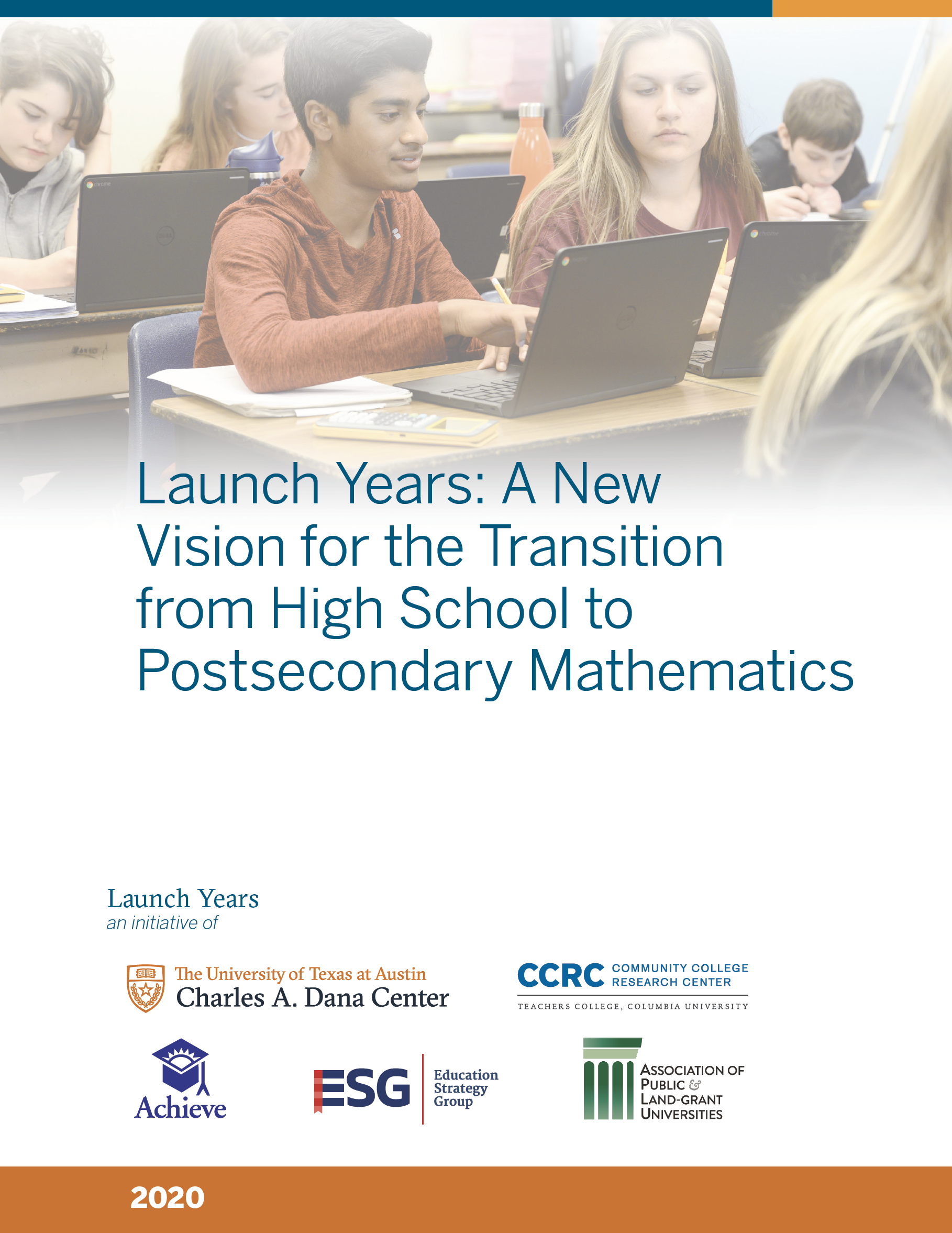
Now Is the Time to Modernize High School Math, New Report Reveals
A new report released today from the Charles A. Dana Center at The University of Texas at Austin uncovers the ways in which the current mathematics structure is blocking students from postsecondary and career success. The report, titled “Launch Years: A New Vision for the Transition from High School to Postsecondary Mathematics,” points to systemic barriers that impede students during the transition from high school mathematics into postsecondary education—and offers clear recommendations to remove those barriers.
 “The fact that our current system of mathematics education fails to meet the needs of a vast number of students is entirely unacceptable,” said Doug Sovde, director of K–12 education strategy, policy and services at the Dana Center. “Through this report and the Launch Years work, we are collaborating closely with leaders from the K–12, higher education, and workforce communities, as well as equity advocates, to intentionally dismantle the structural, institutional, and systemic barriers that lead to inequitable mathematics experiences and access."
“The fact that our current system of mathematics education fails to meet the needs of a vast number of students is entirely unacceptable,” said Doug Sovde, director of K–12 education strategy, policy and services at the Dana Center. “Through this report and the Launch Years work, we are collaborating closely with leaders from the K–12, higher education, and workforce communities, as well as equity advocates, to intentionally dismantle the structural, institutional, and systemic barriers that lead to inequitable mathematics experiences and access."
Download the Launch Years Report
The Launch Years initiative is supported by a $6.68 million grant from the Bill & Melinda Gates Foundation and is an initiative of the Dana Center, Education Strategy Group, Achieve, Community College Research Center, and the Association of Public & Land-grant Universities.
“Reimagining mathematics education is critical for preparing students for success in postsecondary education and the workforce,” said Matt Gandal, president and CEO of Education Strategy Group. “It is encouraging that hundreds of colleges and universities have already diversified their mathematics pathways with a clear eye toward the skills required in the changing economy. Now is the time for K–12 leaders to follow suit and expand access to meaningful mathematics experiences in high school so that math becomes an accelerator and not a barrier to student success."

As the driving force behind the initiative and recent report, the Launch Years Collaborative comprises leaders from K–12 and higher education, state agencies, business and industry, and equity advocates—all focused on establishing a new vision for students’ transition from high school mathematics to postsecondary success.
Currently, the Launch Years initiative is working in three states—Georgia, Washington and Texas— which all have previous experience and success in updating high school mathematics. These states have committed to removing barriers that lead to inequitable outcomes and implementing clear, relevant pathways from high school mathematics into postsecondary settings. Over time, their key learnings will be shared with other states and districts across the country.
To download the full “Launch Years: A New Vision for the Transition from High School to Postsecondary Mathematics” report and to learn more about Launch Years, visit www.launchyearsreport.org/vision.
For media inquiries, contact Allison Murray at amurray@piercom.com.
About the Launch Years
Launch Years is an initiative led by the Charles A. Dana Center at The University of Texas at Austin—in collaboration with Community College Research Center, Achieve, Education Strategy Group, and the Association of Public and Land-grant Universities—focused on addressing systemic barriers that prevent students from succeeding in mathematics and progressing to postsecondary and career success. Leveraging work within states, the initiative seeks to modernize mathematics in high school through relevant and rigorous mathematics courses as well as policies and practices leading to more equitable outcomes for all students. Learn more at: utdanacenter.org/launch-years.
About the Charles A. Dana Center at The University of Texas at Austin
At the Charles A. Dana Center at The University of Texas at Austin, we are passionate about ensuring all students—including those who are Black, Latinx, Native American, or come from low-income backgrounds—have access to excellent math and science education. From kindergarten through postsecondary, we believe every student deserves the same opportunity to experience the joy of learning mathematics and science that are relevant to their futures and set them on a path toward upward social and economic mobility. That’s why we work at every level of the educational system—from local K–12 districts and two- and four-year institutions, all the way through statewide education systems and legislative policy. Every day our staff of more than 70 professionals bring this passion to life, with innovative ideas and research-based best practices in pedagogy, curriculum, instruction, and professional learning. And we do so in a spirit of collaboration, partnership, and innovation, knowing that together, we can make a difference.
Get in Touch
We collaborate with state districts and teachers to develop innovative curricula, resources, and professional development.
